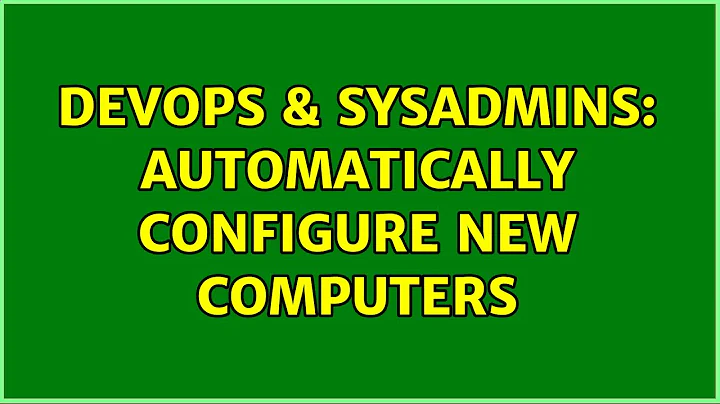Automatically Configure New Computers
Solution 1
Don't bother with uninstalling or fixing bloatware. Just reimage the computers. In fact it's pretty easy to setup a reference image, sysprep, capture, and deploy it using WDS + MDT. See the aforementioned for various driver packages: trust me you're not the first person to think of this stuff, it's been solved already.
Profiles can be transferred with USMT. Mapped drives are best done with a logon script. Outlook 2007+ with Exchange 2007+ can use Autodiscovery. Install updates with WSUS (fully automated at install with a simple script). Keys and Activation can be managed with scripts or VAMT.
Fair warning that if you don't know about any of this stuff already you've got one heck of a learning curve to get through and you're way behind the times. If you really only have a handful of computers it probably isn't worth the time to set this stuff up now, but if it's more than a dozen it's worth the time. Also future hardware refreshes aren't nearly so painful. Bonus that many of these skills allow you to be more efficient in your routine tasks and help prevent problems.
Solution 2
Solution that would work:
Install following applications
-
WDS (windows deployment services)
- Use WDS to provide PXE boot. All laptops can boot via PXE into WDS server.
- WDS will host MDT boot images
-
MDT (Microsoft Deployment Tool)
- Create task sequences to capture your default Windows 7 install
- Create task sequences to install your captured Windows 7 image
- Create task sequences to install Applications
- Automate the installation of HP drivers
-
WAIK (windows automated installation kit)
- Required to automate the Windows 7 Install
- Provides USMT and allow integration from within MDT
All of the above sits inside MDT boot images that is hosted within WDS. Thus during the boot into WDS server you are provided with all of these task sequences.
Create default Windows 7 Image and Capture for re-deployment
- Install Windows 7 as normal
- Uninstall bloatware using PC decrapifier software
- Install Windows updates
- Create MDT task sequence to sysprep and capture image
- Boot into WDS and choose task sequence created and capture Windows 7 Image
When you sysprep a machine it strips the machine back to a state where it can effectively be re-instated with different Product Keys, different drivers, different machine name, differernt SID , etc…. It also boots the machine back to Audit mode – the state a newly bought machine is usually in (U know that Welcome screen you see to complete the final steps of a new PC install).
Configuring MDT Rules to automate yor requirements
-
Licensing - I MDT you can specify a VLM key or use the rules to request a product key to be asked during every deployment. Example of the rule to always ask to provide product key.
SkipProductKey=NO -
Add to domain with different machine name - This can be done with MDT rules. Rules settings below
SkipComputerName=NO SkipDomainMembership=NO JoinDomain=domain.co.uk DomainAdmin=username DomainAdminDomain=domain.co.uk DomainAdminPassword=password
USMT & saving user data
I have not done this before, but in theory you create a standard replace task in MDT, run this on the existing Windows XP PC and USMT will allow you to save the user settings to a network location. You then boot into WDS and run a standard install task for Windows 7 and during the wizard phase specify that you want to restore user settings.
Install applications and pre-configure office & outlook
- Applications can be automatically installed via MDT - you will need to ensure you identify the silent install options for the application so that it does not interrupt MDT during ddeployment phase.
- Office 2007 or 2010 settings (default templates, product keys, etc...) can be configured and installed via MDT (to automatically detect user settings upon first run of outlook you will need exchange 2007 & outlooked 2007)
Upgrade Windows XP to Windows 7
- Again using MDT you need to create a task sequence to deploy the Windows 7 image you captured.
- Set USMT to ensure user settings are saved
- Choose which applications to install during deployment
- Set MDT to re-run windows updates after install
- MDT can also run any scripts or bat files yuo speicfy for any additional functionality (to map drives etc...) Although you are probably better to map drives using AD and group policy
Solution 3
You know. I find the easiest way is to use Symantec Ghost, which essentially means you configure one machine how you want it, snap an image, and then use that image on all the other machines.
If you need the user profile on the old machine, then you can run a free tool called Transwiz on the old machine, save the profile on an external, and then use Transwiz on the new machine, select the profile, and it does all the work. It will transfer documents, profile, application settings, etc, etc. http://www.forensit.com/move-computer.html
At the very end of the day, I use SCCM for my re-imaging needs. I find working with packages easier than working with ghost because they are easier to alter if you need to make subtle changes between machines.
Solution 4
If you do choose to go with the Ghost, Clonezilla or similar "imaging" method, you can make the image work on different chipsets by removing the "disk controller(s)" from inside of Device Manager before shutting down the system for imaging.
Solution 5
In addition to Symantec Ghost, Symantec also has a more enterprise ready solution that leverages Ghost, Symantec Deployment Solution. This product provides the core elements to reimage the systems, but also capabilities to transfer the personality (desktop, screen saver, application templates) to the new OS. And you can automate the entire process with workflows that allow end users to self service the migration. You can check it out at http://www.symantec.com/business/deployment-solution.
Related videos on Youtube
Comments
-
jwegner over 1 year
My company is in the process of upgrading all of our users from old Windows XP computers to newer quad-core Win7 computers. This is a good thing - it's long overdue that we upgrade our workstations - but I now spend a ton of time configuring new computers. Is there any way to automate this process?
The steps that I go through with just about every computer:
- Run through Win7 setup process (we do mostly HPs, so we get the stupid "The computer is personal again" thing.
- Uninstall bloatware (norton, bing bar, roxio, etc.)
- Install Updates
- Add to domain & configure network settings
- Install Office, and other company-specific applications
- Configure important shortcuts (Outlook on task bar)
There's a couple other things that I do after that that would be nice to automate, but it's unlikely due to license keys, passwords, etc.
- Configure Outlook
- Pull in files/settings with easy transfer wizard
- Map network drives
I know that it's possible to create a complete image of a computer, but how does that work with different hardware/drivers? What about Win7 license keys? If there is a way to make this work, what is the best (preferably free/open source) software out there to do this?
-
jwegner over 12 yearsOK - so that sounds good so far. Could you go into a bit of detail on the process of getting a reference image, sysprep, capture, and that WDS + MDT thing? I don't know anything about any of those :)
-
 Philip over 12 yearsI hate to be rude and tell you to follow the links, but detailing reference image -> deployment could easily fill a book. If you've got a specific hangup by all means ask away but the MS docs are a pretty good starting place. Also, MS Certification 70-680 covers most of this stuff, so books prepping for that test will teach you almost all the basics.
Philip over 12 yearsI hate to be rude and tell you to follow the links, but detailing reference image -> deployment could easily fill a book. If you've got a specific hangup by all means ask away but the MS docs are a pretty good starting place. Also, MS Certification 70-680 covers most of this stuff, so books prepping for that test will teach you almost all the basics. -
 MDMarra over 12 years'"Mapped drives are best done with a logon script."` - I disagree that logon scripts are the best way to map drives. Group Policy Preferences for Mapped Drives is great and supports item-level targeting as well as many other cool options are are a PITA to implement with logon scripts. Very good suggestions, otherwise.
MDMarra over 12 years'"Mapped drives are best done with a logon script."` - I disagree that logon scripts are the best way to map drives. Group Policy Preferences for Mapped Drives is great and supports item-level targeting as well as many other cool options are are a PITA to implement with logon scripts. Very good suggestions, otherwise. -
 Tim over 12 yearsYup same here, except I use
Tim over 12 yearsYup same here, except I useclonezilla -
raja over 12 yearsI agree with mdmarra, there are few and specific reasons to use login scripts at all and mapping drives isn't one of them. I'd shy away from wds and just use mdt. I'm not sure where the update script came from but that's certainly not needed if you use mdt (usmt is also built in). Other than that this is a good answer. There is a step by step guide to deploying with mdt on technet
-
raja over 12 yearsIf you use sccm you should try mdt to image. It adds a great deal of flexibility to sccm deployments
-
raja over 12 yearsSpecifically for the HP, do not bother with the mdt driver management scheme, just run the driver installer as an app during the task sequence.
-
 Philip over 12 years@MDMarra &JimB I've had good experiences with GPO Preferences in Win7, so I can't disagree with you in a homogenous environment. I have had too many troubles to count with Preferences in WinXP however, since this is a mixed environment I would recommend against relying on Preferences. It may be the case that the XP machines are already setup so he wouldn't care, if that's the case Preferences are a good way to keep the configuration simplified and collected. Also, I know some of the above are part of one another, just wanted to detail some of the tools for the new guy.
Philip over 12 years@MDMarra &JimB I've had good experiences with GPO Preferences in Win7, so I can't disagree with you in a homogenous environment. I have had too many troubles to count with Preferences in WinXP however, since this is a mixed environment I would recommend against relying on Preferences. It may be the case that the XP machines are already setup so he wouldn't care, if that's the case Preferences are a good way to keep the configuration simplified and collected. Also, I know some of the above are part of one another, just wanted to detail some of the tools for the new guy. -
 Arunkumar over 12 years+1. I usually do just the basics of imaging with Sysprep for 5+ computers here in the shop, but there's a lot more info here than I realized
Arunkumar over 12 years+1. I usually do just the basics of imaging with Sysprep for 5+ computers here in the shop, but there's a lot more info here than I realized -
Kcmamu over 12 years@ChrisS, +1 for the comment regarding preferences and Windows XP. I got burned by that too, and ended up ripping it all back out and going back to using plain old logon scripts. We're planning on moving to Windows 7 in the next year or so I'll probably revisit preferences then, but definitely one to avoid in a mixed/win XP environment.


![How to automatically turn on (Power-On) the computer at a certain time [2021]🔥🔥🔥](https://i.ytimg.com/vi/Xzq9Kq7famU/hq720.jpg?sqp=-oaymwEcCNAFEJQDSFXyq4qpAw4IARUAAIhCGAFwAcABBg==&rs=AOn4CLAfG9N5liPnbcYeJ259ZqV3USGrPQ)

